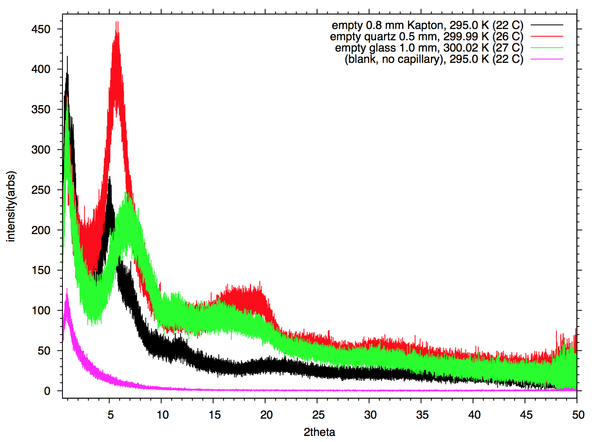Supplies and Tools
Capillaries: Kapton
Kapton is a polyimide film developed by DuPont which is stable in a wide range of temperatures, from −273 to +400 C. (more property details)
11-BM purchases Kapton tubing from the following vendors:
- MicroLumen, Inc. (http://www.microlumen.com/)
- Cole-Parmer (http://www.coleparmer.com/Category/Polyimide_Tubing/6806) {can be purchased via Fisher Scientific}
Rapid-Access
11-BM rapid access mail-in users are provided with Kapton tubes which are compatible with the mail-in mounting bases.
NEW: As of January 2013, the 11-BM rapid access mail-in program offers two sizes of Kapton capillaries and corresponding mounting bases.
- Standard Size = 0.8 mm diameter Kapton tube and mounting base
- Large Size = 1.5 mm diameter Kapton tube and mounting base (NEW)
This new larger 1.5 mm size is ~ 2x larger than the standard 0.8 mm diameter Kapton tube capillary for mail-in samples. The larger size capillaries can be easier to load, and may improve measured data for lower Z samples by placing more diffracting powder in the beam. These larger capillaries are available now for 11-BM mail-in users by special request. Please email 11-BM staff if you are interested once you have made you base request using the emailed links or 11BM webpage.
On-Site
An assortment of Kapton capillary tube sizes are available at 11-BM for on-site experiments. See On-Site_Experiments
Users anticipating performing complimentary scattering measurements on a single sample at other APS powder beamlines should consider using the following standard Cole-Parmer sizes. These are compatible with samples holders at the beamlines noted below. However, it is also important to contact beamline staff for details on sample loading & capillary lengths before preparing your sample for complimentary measurements.
Capillary ID size x OD size, Cole-Parmer Part#, Standard Size @ APS Beamlines 0.0320" (0.81 mm) x 0.0340" (0.86 mm), # 95820-06, @ 11-BM, 17-BM 0.0395" (1.00 mm) x 0.0435" (1.10 mm), # 95820-09, @ 11-ID-B, 17-BM 0.0575" (1.46 mm) x 0.0615" (1.56 mm), # 95820-12, @ 11-BM, 11-ID-B
Sample Preparation for Joint 11-BM and 11-ID-B Measurements
Capillaries: Thin Wall Glass and Fused Quartz
Thin wall glass or fused quartz capillaries are often used in powder diffraction experiments.
These are available from several vendors such as:
- Charles-Supper http://www.charles-supper.com
- Hampton Research http://hamptonresearch.com
Typical both glass ('special' or 'borosilicate') or fused (amorphous) quartz capillaries are available.
As purchased from both vendors above, the tubes are pre-sealed on one end, and have a flared opening on the other end for easy powder loading.
When selecting a capillary material and size, consider your experiment and sample(s).
Glass and quartz are stable over different temperature ranges. Glass adds a lower background to a diffraction pattern and is easier to seal with a flame (you can use Bic style lighter), but fused quartz tubes are stronger, more chemical resistant, and more likely to survive shipping and handling.
On-Site
An assortment of glass or fused quartz capillaries are available at 11-BM for on-site experiments. See On-Site_Experiments
Rapid-Access
11-BM rapid access mail-in users may find nested glass/quartz capillaries to protect air sensitive samples, or to lower the sample x-ray absorption
Any additional nested capillary must fit entirely within and be secured inside the supplied Kapton tube.
The beamline does not provide glass or quartz capillaries for mail-in experiments. Purchase them vendors like those mentioned above. If returning samples with nested in glass/quartz capillaries, please leave a note in the package so we be sure to take extra care when handling.
Capillaries: Background
The capillary holding your sample contributes a weak diffraction pattern to the total sample scattering. For nearly all measurements at 11-BM, the capillary contribution can be ignored. Kapton, fused quartz, and glass contribute similar but slightly different patterns. The overall intensity varies with the capillary diameter and wall thickness, but in general the fused quartz gives the largest "background".
See the plot below for a comparison. Data on capillaries listed in the legend were collected over ~ 1 hour each at 298 K and 30 keV using identical standard mail-in scan parameters.
Drill Bits
A #68 wire gauge size Jobber drill bit (diameter = 0.031" = 0.787 mm) can be useful for loading & packing powder inside the standard 11-BM mail-in 0.8 mm Kapton tubes. For the larger mail-in capillaries, use a #54 bit (0.0550" = 1.397 mm).
These small diameter drill bits cost $2 or less, and can easily be purchased online. If you intend to use it frequently, you might consider also purchasing a small pin vise (Starrett makes good ones) to more easily hold the small bit.
Powder Sieves
11-BM has a selection of powder sieves available for use by on-site users.
Small and large agate mortars and pestles are also available for grinding powders.
The available sieve sizes are as follows.
| Sieve # | Mesh (microns) |
|---|---|
| 40 | 425 μm |
| 70 | 212 μm |
| 140 | 106 μm |
| 200 | 75 μm |
| 325 | 45 μm |
Mortar and Pestle
An agate mortar and pestle is an invaluable tool for grinding powder samples. Can you used with dry or wet powders. 11-BM has a selection of mortar and pestles available for use by on-site users at the beamline.
